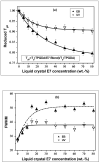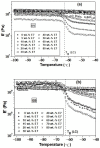Temperature Controlled Mechanical Reinforcement of Polyacrylate Films Containing Nematic Liquid Crystals
- PMID: 36433151
- PMCID: PMC9693148
- DOI: 10.3390/polym14225024
Temperature Controlled Mechanical Reinforcement of Polyacrylate Films Containing Nematic Liquid Crystals
Abstract
This investigation reports on the thermomechanical properties of Poly-tripropyleneglycoldiacrylate (Poly-TPGDA)/liquid crystal (LC) blends, developed via free radical polymerization processes, which are induced by Electron Beam (EB) and Ultraviolet (UV) radiation. The EB-cured Poly-TPGDA network exhibits a higher glass transition temperature (Tg), a higher tensile storage, and Young moduli than the corresponding UV-cured sample, indicating a lower elasticity and a shorter distance between the two adjacent crosslinking points. Above Tg of Poly-TPGDA/LC blends, the LC behaves as a plasticizing agent, whereas, for EB-cured networks, at temperatures below Tg, the LC shows a strong temperature dependence on the storage tensile modulus: the LC reinforces the polymer due to the presence of nano-sized phase separated glassy LC domains, confirmed by electron microscopy observations. In the case of the UV-cured TPGDA/LC system, the plasticizing effect of the LC remains dominant in both the whole composition and the temperature ranges explored. The rubber elasticity and Tg of Poly-TPGDA/LC films were investigated using mechanical measurements.
Keywords: UV-visible irradiation; dynamical mechanical analysis; elastic modulus; electron beam curing; glass transition; liquid crystals; polyacrylates.
Conflict of interest statement
The authors declare that they have no known competing financial interests or personal relationships that could have appeared to influence the work reported in this paper.
Figures








Similar articles
-
Glassy state molecular mobility and its relationship to the physico-mechanical properties of plasticized hydroxypropyl methylcellulose (HPMC) films.Int J Pharm X. 2019 Aug 23;1:100033. doi: 10.1016/j.ijpx.2019.100033. eCollection 2019 Dec. Int J Pharm X. 2019. PMID: 31528853 Free PMC article.
-
Thermomechanical investigation of poly(methylmethacrylate) containing an organobismuth radiopacifying additive.J Biomed Mater Res. 1996 Jul;31(3):339-43. doi: 10.1002/(SICI)1097-4636(199607)31:3<339::AID-JBM7>3.0.CO;2-N. J Biomed Mater Res. 1996. PMID: 8806059
-
Mechanical Properties and Morphologies of Carboxyl-Terminated Butadiene Acrylonitrile Liquid Rubber/Epoxy Blends Compatibilized by Pre-Crosslinking.Materials (Basel). 2016 Jul 29;9(8):640. doi: 10.3390/ma9080640. Materials (Basel). 2016. PMID: 28773762 Free PMC article.
-
Viscoelastic Properties of Epoxidized Natural Rubber/Poly(lactic acid) PLA/ENR Blends Containing Glycidyl-POSS and Trisilanolisooctyl-POSS as Functional Additives.Materials (Basel). 2021 May 20;14(10):2686. doi: 10.3390/ma14102686. Materials (Basel). 2021. PMID: 34065561 Free PMC article.
-
A UV-cured nanofibrous membrane of vinylbenzylated gelatin-poly(ɛ-caprolactone) dimethacrylate co-network by scalable free surface electrospinning.Mater Sci Eng C Mater Biol Appl. 2018 Oct 1;91:541-555. doi: 10.1016/j.msec.2018.05.076. Epub 2018 May 28. Mater Sci Eng C Mater Biol Appl. 2018. PMID: 30033285
References
-
- Rudin A., Choi P. The Elements of Polymer Science & Engineering. 3rd ed. Academic Press; London, UK: 2013. Chapter 9—Copolymerization; pp. 391–425. - DOI
-
- Guerrero-Santos R., Saldívar-Guerra E., Bonilla-Cruz J. Chapter 4—Free Radical Polymerization. In: Saldívar-Guerra E., Vivaldo-Lima E., editors. Handbook of Polymer Synthesis, Characterization, and Processing. John Wiley & Sons, Inc.; Hoboken, NJ, USA: 2013. pp. 65–83. - DOI
-
- Sanai Y., Kubota K. Effect of UV-curing conditions on the polymer structures: A comparison between coating and adhesive. Polym. J. 2020;52:1153–1163. doi: 10.1038/s41428-020-0347-4. - DOI
LinkOut - more resources
Full Text Sources
Miscellaneous

